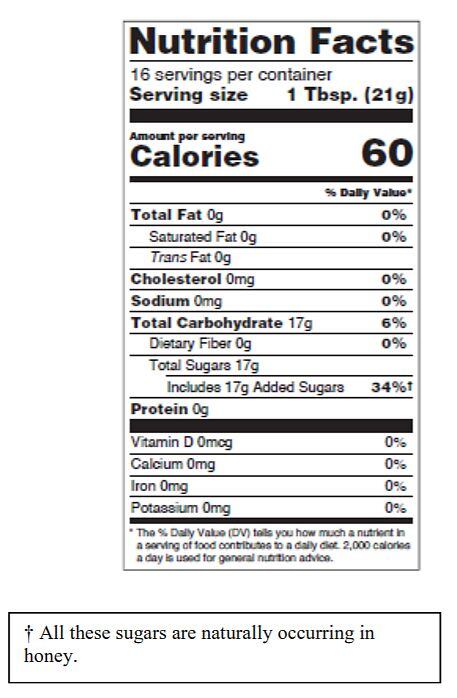The agency will also unveil an education campaign to promote the new-look Nutrition Facts label - coming into effect for large companies In January 2020 and smaller ones in January 2021 - which will include “educational videos, social media campaigns and user-friendly websites,” said FDA commissioner Dr Scott Gottlieb.
The campaign will be “timed to begin when the updated labels are fully implemented in the marketplace,” added Dr Gottlieb, who plans to issue a final rule on the label in the spring.
Honey, maple syrup, cranberry products
In the added sugars draft guidance - the FDA clarified its position on honey, maple syrup and certain cranberry products following feedback from stakeholders, said Dr Gottlieb.
“While honey and maple syrup meet the definition of added sugars, we heard concerns from industry that declaring added sugars on their single ingredient products may lead consumers to think their pure products – such as a jar of honey or maple syrup – actually contain added table sugar because added sugars are listed on the Nutrition Facts label. We also heard from cranberry juice manufacturers that their products need to be sweetened for palatability ... “
To address these concerns, FDA proposes that manufacturers use a ‘†’ symbol immediately after the added sugars daily value, directing consumers to a statement* on pack “that provides truthful and not misleading contextual information about ‘added sugars’ and what it means for each of these specific products.”
Dietary fibers
When it comes to dietary fibers, the FDA is still in the process of pinning down whether certain non-digestible carbohydrates the food industry has become accustomed to describing as dietary fibers should really be classified as such for regulatory purposes, said Dr Gottlieb.

Guidance issued this morning, however, guides industry on “how to meet the new standards before we make final decisions on these petitions [submitted by industry calling for the FDA to recognize multiple non-digestible carbs as dietary fibers],” he explained.
“We’ll give petitioners who may want to add information to their petition the opportunity to revise those filings based on the more detailed guidance.”
Among other things, when reviewing scientific data submitted by petitioners, the FDA “intends to evaluate whether the scientific evidence supports a beneficial physiological effect to the general U.S. population [as opposed to a small sub-group].”
As to whether it will consider studies on diseased populations as opposed to healthy populations, the FDA said it would “consider evidence from studies with subjects who have a disease that is associated with the beneficial physiological effect of interest when extrapolating to individuals who do not have the disease is scientifically appropriate.”
It will also consider studies on 'at risk' populations, for example people at risk of developing heart disease or type 2 diabetes because they have elevated LDL cholesterol levels, metabolic syndrome, or abnormal glucose tolerance tests.
Serving sizes
In final guidance on serving sizes, meanwhile, the FDA listed appropriate reference amounts customarily consumed (RACC) for a variety of products to help manufacturers determine appropriate serving sizes to include on product labels.
Under the final rule, regardless of the size of the RACC, all products that are packaged and sold individually and contain less than 200% of the applicable reference amount for that product must be labeled as a single serving container. For example, the serving size for beverages will be 12oz (instead of 8oz today), so if you have a beverage that is in a 23oz can, it counts as one serving.
'Clarity' on food label claims to come?
In a statement accompanying the documents issued this morning, Dr Gottlieb also hinted at other changes to come: “In the weeks ahead, I’ll provide more details on a nutrition strategy to reduce preventable death and disease through better nutrition.
"This effort will … provide consumers with helpful tools to make healthy food choices, including clarity on food label claims, and will create incentives for food producers to manufacture products that are healthier.”
CSPI: Earlier compliance date is 'realistic and achievable'
The Center for Science in the Public Interest welcomed the publication of the guidance documents, which special projects director Jim O'Hara said were "largely reasonable and scientifically sound," but urged the agency to re-think its plan to delay compliance dates to 2020/2021.
He added: "[The guidance] should cause the agency to re-think its proposed delay of the upgraded Nutrition Facts label. With today’s release of the guidance, a July 2019 compliance date for all companies for the updated Nutrition Facts label is both realistic and achievable."
*Manufacturers could explain, for example, that no sugar was added to the pure honey or pure maple syrup or that the sugar added to dried cranberries or cranberry juice “is meant to increase the palatability of the naturally tart fruit and that the amount of total sugars per serving is at a level that does not exceed the amount of total sugars in a comparable product with no added sugars.”
